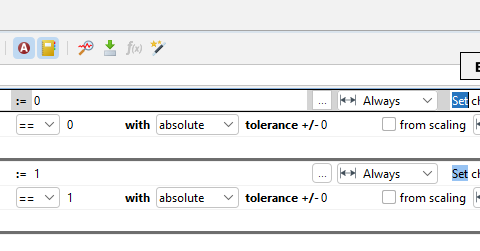
Test modeling / test design in TPT.
Test cases in TPT describe the stimulation of the system under test with signal characteristics and function calls. You can model a simple test with consecutive test steps. For more complex test cases, TPT offers graphical modeling with hybrid automatons and test steps. No matter which method you apply, the test cases are easy to read and easy to maintain thanks to the use of natural language.
Temporal signal characteristics can be generated either with formulas, in tables, or from external measurement data. Both hierarchical and parallel behavior can be modeled with TPT.
From a single test model, you can quickly and easily create a large number of meaningful test cases by combining various state variants. TPT also offers many automatic test generation methods to support you in modeling tests.
Test cases in TPT are reactive, that is, you can specify during modeling what should happen within a state when certain prerequisites are given or are missing. You can also specify when a state is to be entered and whether values are to be adjusted during the transition.
TPT supports various test methods. Functional black-box tests, structural or white-box tests, module tests, integration tests: all these test methods can be easily modeled with TPT. For example, TPT offers great support for equivalence class tests including the special case of boundary value tests, for interface tests, requirements-based tests or for fault injection tests. Test execution is easy and can be repeated as often as desired even in different environments, so that regression and back-to-back tests can be performed without much effort.
Test step lists.
Test steps are made up of sequences of commands. These sequences are processed consecutively or in parallel.
You can model test steps using hierarchies, conditional statements, parallel sequences, reactive behavior, or loops.
Signals are defined by assigning values, time-dependent synthetic functions, or by imported measurement data. You can embed or link measurement data from various file formats like *.csv, *.dat, *.mat, *.mf4, *.mdf, *.tptbin or *.xls in test step lists.
-
- You use the Compare Step to check if a condition is true. Here: when the light_switch is set to “on”, check if the headlight is “on” too.
-
- You can run test steps simultaneously.This feature complies with the parallel automatons in the graphical test modeling.
-
- You can set up direct definitions as a single-line mathematical formula. Or you use the convenient Direct Definition Function Wizard.
-
- You can deactivate test steps in a test step list to exclude them from the test execution. You can, of course, activate them again easily.
-
- Inside a test step list, you can change parameter values, as well as reset single parameters or all parameters to their default value.
Test modeling using automatons.
To model tests graphically, extended state-transition-diagrams, called TPT-automatons, are used. A TPT-automaton specifies graphically which states and phases are part of the test, how much time a state consumes, and under which conditions states may change.
The different combinations of state sequences, variants of states, and transition conditions constitute individual test cases. These individual test cases are not viewed independently but they are presented in a joint model, where similarities as well as differences between the test cases clearly stand out. Moreover, this way the tester gains a detailed overview of the aspects that were tested and those that weren’t yet.











